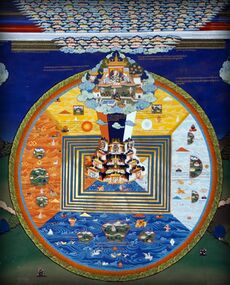Four continents
Jump to navigation
Jump to search
Four continents (Skt. caturdvīpa; T. gling bzhi གླིང་བཞི་; C. [da][bu]zhou [大][部]洲).[1] According to traditional Buddhist cosmology, our world system is comprised of four continents and eight subcontinents surrounding Mount Meru.[2]
The four continents are:[3][4]
- Pūrvavideha ("sublime body") in the East, which is semi-circular and white in colour;
- Jambudvipa ("land of Jambu") in the South, which is trapezoidal and blue (this is the continent we human beings live in);
- Aparagodānīya ("bountiful cow") in the West, which is circular and ruby in color; and
- Uttarakuru ("unpleasant sound") in the North, which is square and green.
Dudjom Rinpoche states:
- Outside the seven golden mountain ranges are the four great continents, whose colors correspond to those of the four sides of Mount Meru. In the east is Purvavideha, which is semicircular in shape. To the south is the triangular Jambudvipa. In the west is Aparagodaniya, which is round. In the north is Uttarakuru, which is square. To the right and left of each of these four continents are the eight subcontinents: Deha and Videha in the east, Chamara and Aparachamara in the south, Shatha and Uttaramantrina in the west, and Kurava and Kaurava in the north. They have the same color and shape as their respective main continents and are half their size.
- The eastern continent is full of mountains of diamonds, lapis lazuli, sapphires, emeralds, pearls, gold and silver, crystals, and other precious minerals. The southern continent is covered with a great forest of wish-fulfilling trees from which everything one could want or need falls like rain. The western continent swarms with herds of elephants and cows from whose every hair flows an inexhaustible supply of everything one could desire. The northern continent is filled with crops that need no cultivation: they yield a hundred flavors and a thousand powers, dispelling all illness, negative forces, hunger, and thirst.[3]
Human beings inhabit these continents with the exception of of the subcontinent of Chamara (rnga yab), which is populated by rakshasas, a kind of flesh-eating demon.[4]
The humans beings on each continent have different characteristics, life styles and life-spans.[5]
Notes
- ↑ Buswell & Lopez 2014, s.v. List of Lists, "four continents".
- ↑
 གླིང་བཞི་, Christian-Steinert Dictionary
གླིང་བཞི་, Christian-Steinert Dictionary
- ↑ 3.0 3.1 Dudjom Rinpoche 2011, s.v. Chapter 12.
- ↑ 4.0 4.1 Jigme Lingpa & Kangyur Rinpoche 2010, Glossary, "four continents".
- ↑
 Four continents, Rigpa Shedra Wiki
Four continents, Rigpa Shedra Wiki
Sources
 Dudjom Rinpoche (2011), A Torch Lighting the Way to Freedom: Complete Instructions on the Preliminary Practices, translated by Padmakara Translation Group, Shambhala
Dudjom Rinpoche (2011), A Torch Lighting the Way to Freedom: Complete Instructions on the Preliminary Practices, translated by Padmakara Translation Group, Shambhala Jigme Lingpa; Kangyur Rinpoche (2010), Treasury of Precious Qualities, Book One, translated by Padmakara Translation Group, Boston: Shambhala Publications
Jigme Lingpa; Kangyur Rinpoche (2010), Treasury of Precious Qualities, Book One, translated by Padmakara Translation Group, Boston: Shambhala Publications
Further reading
- Jamgön Kongtrul, Myriad Worlds (Ithaca: Snow Lion, 1995), pages 110-113 & 138-140, ISBN 978-1559391887
 Four_Continents, Rangjung Yeshe Wiki
Four_Continents, Rangjung Yeshe Wiki
